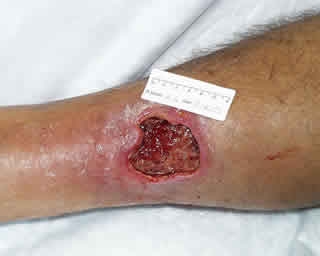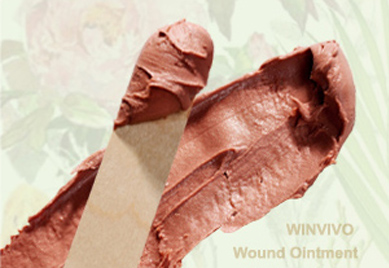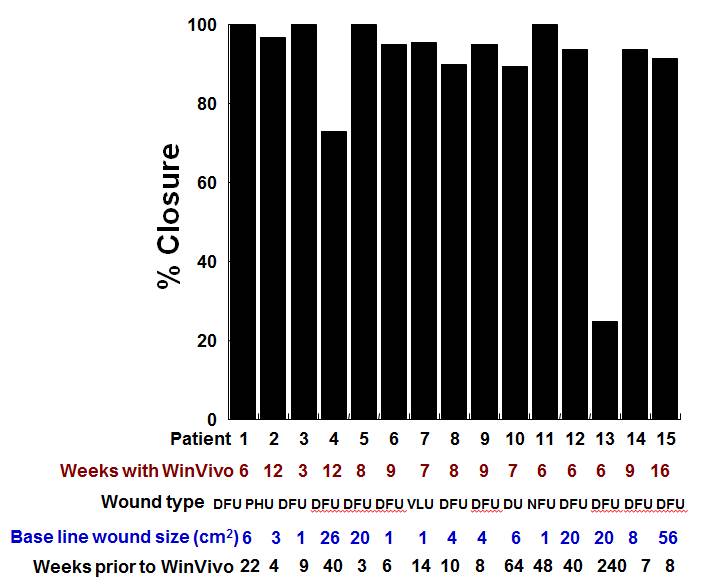Venous Leg Ulcers
 Between 500,000 and 800,000 Americans are affected by venous leg ulcers annually. In the United States alone, venous ulcers cause the loss of 2 million working days and incur treatment costs of approximately $3 billion per year.
Between 500,000 and 800,000 Americans are affected by venous leg ulcers annually. In the United States alone, venous ulcers cause the loss of 2 million working days and incur treatment costs of approximately $3 billion per year.
Across the world, venous ulcerations create an enormous economic burden. This is because of the chronicity of these ulcers, the nursing time required to manage them, and the dressing and bandage costs over a long period of time. The patients in addition suffer from poor quality of life as a result of pain, malodor, and reduced mobility. Moreover, once healed, up to one-third of treated patients experience four or more episodes of recurrence.
Venous leg ulcers (VLU) are chronic skin wounds that occur on the lower leg secondary to the chronic venous insufficiency (CVI) when the veins in the legs are unable to pump venous blood effectively. Chronic venous insufficiency is a term describing the changes that can take place in the tissues of the leg, due to longstanding high pressure in the veins. This high pressure in the veins usually occurs:
-
when blood flow in the veins is abnormal, secondary to venous valve incompetence, causing reverse flow (reflux) in the veins, or
-
when the veins in the legs become blocked (less common).
The prolonged high pressures in the veins appear to lead to low level chronic inflammation in the surrounding tissues and may lead to thickening and discoloration of the skin of the legs, stasis dermatitis and non-healing ulcers around the ankle area.
Stasis Dermatitis
Stasis dermatitis (or stasis eczema) occurs when varicose veins cause fluids to build up in the lower legs. The swelling produces pressure beneath the skin and prevents adequate blood and oxygen from reaching the skin. This causes the skin at the ankles and shins to develop redness (erythema), scales, erosions, crust and itch. Scratching of itchy areas may lead to an open wound, which could turn into a non-healing ulcer. Conventional treatment options usually include:
- Wearing elastic support hose (compression)
- Leg elevation
- Having varicose vein surgery
- Using moist dressings to soften the thickened yet fragile skin and to control infection
Ulceration
Venous ulcers (VU) are ulceration of the skin and subcutaneous that occurs secondary to chronic venous insufficiency. Typical venous ulcers are located on the inner part of the ankles. The base of ulcer is usually red in color and may be covered with yellow fibrous tissue. There may be a green or yellow discharge if the ulcer is infected. Fluid drainage can be significant. The ulcers are usually irregularly shaped. The surrounding skin is often discolored and swollen. The skin may appear shiny and tight, depending on the degree of swelling.
Treatment of Venous Leg Ulcers
Venous leg ulcers are usually recurrent, and an open ulcer can persist for weeks to many years. Conventional treatment options for venous leg ulcers include leg elevation, compression therapy to minimize swelling (edema) and pain, and dressings.
Venous leg ulcers are difficult to heal due to many complex issues, including:
- Increased venous pressure, aggravated by prolonged standing or sitting
- Excessive wound drainage and formation of bacterial biofilms that are resistant to antibiotic treatment
- Swelling (edema)
- Excessive wound drainage (exudation)
- Poor blood circulation (ischemia)
- Disrupted epidermal barrier and susceptibility to infection
- Infection with antibiotic-resistant biofilms
- Eschar and fibrous tissue formation
- Itch, burning sensation and pain
- Prolonged inflammation
- High risk for recurrence, as many patients have to continue doing the same job with lengthy periods of sitting or standing, counterproductively contributing to elevated venous pressure and ultimately, wound healing.
Facing these challenges and to improve the speed and quality of healing, one may consider using a multi-functional botanical therapy with these features:
- Including botanicals with broad-spectrum anti-microbial properties to protect wound bed from infection and to inhibit formation and growth of bacterial biofilms without harming nascent, delicate regenerating tissue;
- Employing naturally anti-inflammatory and analgesic botanicals to suppress prolonged inflammation and pain;
- Combination with botanicals that promote microcirculation of the low extremities to allow fast drainage and tissue regeneration;
- Ability to absorb wound fluid (exudate) and reduce malodor, and yet maintain a physiologically moist wound healing environment without causing maceration
- Allowing painless and less frequent dressing change;
- Healing wounds fast and effectively with maximum restoration of skin function and minimal scarring to reduce the chance of recurrence.
Related Product
WINVIVO Wound Ointment
 This is a uniquely-effective, multi-functional botanical ointment clinically proven to accelerate healing of chanllenging wounds and skin ulcers. Its unique paste formulation includes naturally antimicrobial, anti-inflammatory and analgesic botanicals to inhibit infection, suppress itching and painm promote microcirculation and tissue generation.
This is a uniquely-effective, multi-functional botanical ointment clinically proven to accelerate healing of chanllenging wounds and skin ulcers. Its unique paste formulation includes naturally antimicrobial, anti-inflammatory and analgesic botanicals to inhibit infection, suppress itching and painm promote microcirculation and tissue generation.
Botanicals in WINVIVO Wound Ointment
Borneol resin (Dryobalanops aromatica)
Borneol resin has been shown to be antibiotic having an inhibitory effect against Staphylococcus aureus, Diplococcus pneumonia, E. coli, Pseudomonas aeruginosa, and other dermatophytes. It has been used to treat dizziness, otitis, and various forms of abscesses and swellings.
 Camellia Oil or Tea Seed Oil (Camellia oleifera)
Camellia Oil or Tea Seed Oil (Camellia oleifera)
Composed mainly of Oleic acid (almost 82%, the highest among all natural oils), camellia oil is the most penetrative of all natural oils, capable of permeating deeply into the lower layers of the skin to greatly enhance the beneficial effects of our natural collagen and elastin.
Coptis root (Coptis chinensis Franch.)
 The dried rhizome of Coptis chinensis Franch is used in the preparation of the Healing Balm. Traditional Uses of Coptis Root The first record for medical use of coptis has been appeared in the Chinese medical literature of The Divine Farmer’s Materia Medica (25 A.D. to 220 A.D).
The dried rhizome of Coptis chinensis Franch is used in the preparation of the Healing Balm. Traditional Uses of Coptis Root The first record for medical use of coptis has been appeared in the Chinese medical literature of The Divine Farmer’s Materia Medica (25 A.D. to 220 A.D).
Corydalis tuber (Corydalis turtschaninovii)
 Corydalis tubers have been shown to be analgesic, sedative and tranquilizing but has not been shown to cause dependence, and to be anti-inflammatory in inhibiting histamine release and formation of edema in animals in both acute and chronic phases of inflammation.
Corydalis tubers have been shown to be analgesic, sedative and tranquilizing but has not been shown to cause dependence, and to be anti-inflammatory in inhibiting histamine release and formation of edema in animals in both acute and chronic phases of inflammation.
Dragon's Blood resin (Daemonorops draco)
 Traditionally, Dragon's Blood resin has been used externally to stop bleeding, promote generation of flesh, and contain ulceration in the treatment of traumatic injuries, non-healing ulcers and hemorrhoids with swelling and pain.
Traditionally, Dragon's Blood resin has been used externally to stop bleeding, promote generation of flesh, and contain ulceration in the treatment of traumatic injuries, non-healing ulcers and hemorrhoids with swelling and pain.
Fritillaria (Fritillaria cirrhosa)
 For thousands of years fritillaria has been used in Asia to clear heat and to moisten the lung dryness, for heat-type bronchitis with dry cough and for the heart (to calm heart fire). Fritillaria is also used for treating lumps beneath the skin, such as scrofulous swellings and breast lumps.
For thousands of years fritillaria has been used in Asia to clear heat and to moisten the lung dryness, for heat-type bronchitis with dry cough and for the heart (to calm heart fire). Fritillaria is also used for treating lumps beneath the skin, such as scrofulous swellings and breast lumps.
Lithospermum root (Lithospermum erythrorhizon)
 In modern reserach, lithospermum root has marked anti-inflammatory effects and promotes healing. It has been used clinically to treat psoriasis, burns, cervical erosion, and hepatitis.
In modern reserach, lithospermum root has marked anti-inflammatory effects and promotes healing. It has been used clinically to treat psoriasis, burns, cervical erosion, and hepatitis.
Rhubarb root (Rheum palmatum)
 In traditional Chinese Medicine, rhubarb is used extensively as a purgative to treat a wide variety of accumulations, including constipation caused by excess heat, epigastric distention, fullness.
In traditional Chinese Medicine, rhubarb is used extensively as a purgative to treat a wide variety of accumulations, including constipation caused by excess heat, epigastric distention, fullness.
Tree peony bark (Paeonia suffruticosa Andr.)
 This botanical is used for clearing heat and cools blood, invigorating blood circulation and dispersing blood stasis in traditional Chinese Medicine.
This botanical is used for clearing heat and cools blood, invigorating blood circulation and dispersing blood stasis in traditional Chinese Medicine.
Note:
Please be advised that the information presented above is not to be used as a substitute for medical advice, diagnosis or treatment of any disease. Statements made about products have not been evaluated by the Food and Drug Administration. Viewers should not rely solely on the information provided on this web site for their own health problems, and are advised to consult with their physicians or other healthcare providers.
User Experience
- Girlfriend Set Me Straight
~ Pamela W.
- I am very into natural remedies
~ Alex H.
- Headache Gone Overnight
~ Josh L.
- Blocked sickness on the way
~ Jeff C.
Related FAQs
WINVIVO Wound Ointment:
Multi-Functional Botanical Therapy
- Difficult-to-Heal Wounds
Clinical Case Reports
- Diabetic Foot Ulcers
- Venous Leg Ulcers
- Skin Ulcers of Mixed Etiology
- Pressure Ulcers/Bedsores
- Surgical Wounds
- Traumatic Wounds


Privacy Policy | Disclaimer | Knowledge Garden Disclaimer | Return Policy | Contact Us | Affiliate Program
© 2009-2013 WinVivo Corporation All Rights Reserved






